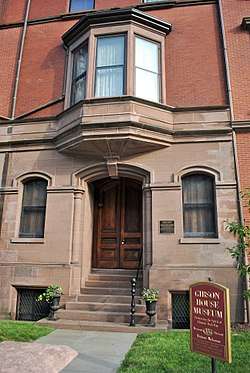Charles Hammond Gibson Jr
Charles Hammond Gibson, Jr. (1874 – November 17, 1954) was an American author from a wealthy Bostonian family who created the Gibson House Museum to preserve his family mansion as a Victorian time-box.

Biography
Charles Hammond Gibson was born on 1874 the son of Charles Hammond Gibson, Sr (1836-1916), and Rosamond Warren (1846-1934). He had two sisters, Mary Ethel (1873-1938, married Freeman Allen) and Rosamond (1878-1953, married Charles Gibson Winslow).[1]
He attended private schools in Boston; then St. Paul's School in Concord, New Hampshire and finally the School of Architecture at the Massachusetts Institute of Technology, but never graduated.[1][2]
After school, he travelled to Europe and became the secretary of Alfred Harmsworth, 1st Viscount Northcliffe, assisting him in the preparation of the Jackson-Harmsworth Polar Exposition of 1894.[2]
He wrote poetry, publishing his first sonnet in the Boston Transcript in 1894. He privately printed The Spirit of Love and Other Poems (1906) and The Wounded Eros, Sonnets (1908), one novel Two Gentlemen in Touraine (1899) (as Richard Sudbury, a fictional romance about the relationship with Maurice Talvande, Count de Mauny Talvande, owner of Taprobane Island, but also a chronicle of castles and churches in France, which became a sought after travel book), and one illustrated travel book, Among French Country Inns.[3] He dedicated his poetry to Winston Churchill and Queen Elizabeth II, who both sent back thank you notes.[1]
He was chairman and charter member of the Boston Authors Club, he was at the organizational meeting at the home of Julia Ward Howe.[2] Beginning of the 1900s he worked as an investment banker.[4]
Gibson was also famous for his rose gardens that he created at Forty Steps, the family's summer home in Nahant, Massachusetts.[1]
In 1906 he was invited to the White House for the wedding of Alice Roosevelt Longworth; the invitation came directly from President Theodore Roosevelt.[1]

In 1909, Gibson moved to 59 Beacon and then, in 1910, to 48 Beacon. He continued to live there until 1911-1912 when he moved to 121 Beacon. After his father died in 1916, he moved back with his mother at 137 Beacon, the family mansion.[4]
In 1914 he was appointed Boston's parks commissioner and under this role he designed a "convenience station" for the Boston Common inspired by the Petit Trianon at Versailles; nicknamed the "Gibson’s Folly", it recently reopened as a restaurant.[1][2]
In February 1953 answering a request from Harvard University, he recorded himself reading his own poetry, and those recordings are available today at The Woodberry Poetry Room, part of Harvard’s Houghton Library and housed in Lamont Library.[5]
He died on November 17, 1954, and is buried at Mount Auburn Cemetery. Between 1847 and 1849 Edward Clarke Cabot designed what is now the Gibson House Museum for Catherine Hammond Gibson and her son Charles Hammond Gibson. Three generation of the Gibson family lived there before Charles Hammond Gibson, Jr. ensured the house would be preserved "as is" a time-box of the Victorian era. It opened 3 years after his death.[1] When asked by LGBT visitor if Gibson was gay, Jonathan Vantassel, guide at the museum, said "It’s very clear that he was very open and proud about who he was, [...] I think that absolutely we have to... give that to our visitors. Otherwise, we’re not telling the whole story."[6]
Legacy
The Wounded Eros - Remembering Charles Hammond Gibson. Jr. (1874-1954) is a short movie Todd Gernes.[3]
References
- Brown, Nell Porter. "Preserving Heirs and Airs". harvardmagazine. Retrieved 6 January 2018.
- "Charles Hammond Gibson, Jr. (1874–1954)". The Gibson Museum. Archived from the original on 6 January 2018. Retrieved 6 January 2018.
- "The Wounded Eros - Remembering Charles Hammond Gibson. Jr". Vimeo. Retrieved 6 January 2018.
- "137 Beacon". Back Bay Houses. Retrieved 6 January 2018.
- "Listning Booth: Gibson". Harvard University. Archived from the original on 8 December 2017. Retrieved 6 January 2018.
- "A Gloucester mansion leads the way for LGBT figures". Boston Globe. Retrieved 6 January 2018.